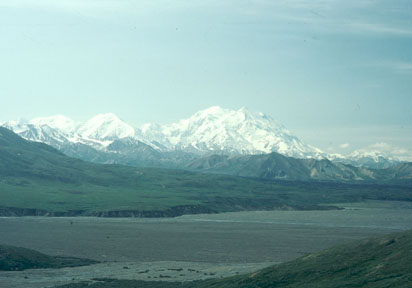
Mt. McKinley, Denali National Park, Alaska (c) 2005 Carol and Steve Baskauf
Bioimages home (click on an image to enlarge)
view
this page in its intended navigation context
Alaska-St. Elias Range tundra
(WWF
ecoregion NA1101)

Mt. McKinley, Denali National Park, Alaska
(c) 2005 Carol and Steve Baskauf

Source of bioregions data:
Olson, D. M. and
E. Dinerstein. The Global 200: Priority ecoregions for global conservation. (PDF
file) Annals of the Missouri Botanical Garden 89:125-126.
Distinctiveness (1=highest,4=lowest): 2
(regionally outstanding)
This ecoregion has an entirely intact ecosystem including top-level predators
including brown bears.*
Conservation Status (1=most endangered, 5=most
intact): 5 (relatively intact)
There is little habitat loss or fragmentation.*
 l
l Picea glauca (white spruce)
Picea glauca (white spruce) Picea mariana (black spruce)
Picea mariana (black spruce) Populus
tremuloides (quaking aspen)
Populus
tremuloides (quaking aspen) Ovis
dali dali (Dall sheep) (c) 2005
Carol and Steve Baskauf
Ovis
dali dali (Dall sheep) (c) 2005
Carol and Steve Baskauf
 Alopex
lagopus (arctic fox) (c) 2005
Carol and Steve Baskauf
Alopex
lagopus (arctic fox) (c) 2005
Carol and Steve Baskauf
 Rangifer
tarandus (caribou) (c) 2005
Carol and Steve Baskauf
Rangifer
tarandus (caribou) (c) 2005
Carol and Steve Baskauf
 Ursus
acrtos (brown bear) (c) 2005
Carol and Steve Baskauf
Ursus
acrtos (brown bear) (c) 2005
Carol and Steve Baskauf
 Lagopus
lagopus (willow ptarmigan) (c) 2005
Carol and Steve Baskauf
Lagopus
lagopus (willow ptarmigan) (c) 2005
Carol and Steve Baskauf
Some views from the ecoregion

Denali National Park, Alaska (c) 2005
Carol and Steve Baskauf
hires
* Ricketts, T.H., E. Dinerstein, D.M. Olson, C.J. Loucks, et al. (1999) Terrestrial Ecoregions of North America: A Conservation Assessment. World Wildlife Fund - United States and Canada. Island Press, Washington, D.C. pp. 337-340.
Except as noted, images copyright 2002-2005 Steve Baskauf - Terms of use